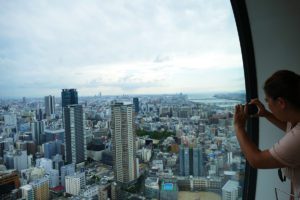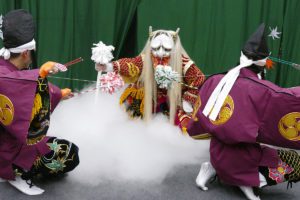Tokyo – my first encounter with Japanese everyday life and culture – left a good impression and prepared me for more to come – hence, let me guide you to ten of its most extraordinary neighborhoods.

Tokyo – the first cut is the deepest. However, this one didn’t hurt at all.
Conceiving the City of Tokyo
Tokyo has about 9 million inhabitants. Reading those high numbers when it comes to cities is always a bit intimidating. Funny enough, once there, you don’t perceive it that way. After all, all of those 9 million people are rarely in the same spot at the same time.
Actually, particularly in Tokyo, it’s like visiting many different small cities. Not villages, Tokyo is definitely a metropolis with nothing provincial to it. However, the various neighborhoods are absolutely distinctive.
Albeit the city is not intimidating, it is, however, huge. Hence, although the public transportation system in Tokyo is impeccable – extensive and comprehensive, frequent, reliable, clean – travelling from one neighborhood to another can take forever.
Therefore, when planning your visits, it’s a good idea to stick to certain areas. Before you go, look at the map and figure out where to find the landmarks, parks, temples, and museums that you want to see. Eventually, pool them to save time. A good way is to visit by neighborhood.
I put together my itineraries below exactly according to this time-saving rule. I’d be happy if it inspires you and helps you make the most of your visit to wonderful Tokyo.
Akihabara
It’s evening. The night has fallen. It’s dark. However, Akihabara’s streets are illuminated like the stage at a theater would be. Blindingly bright around the light source, indirect and diffuse only a couple of meters farther.

In this half-dark, a large crowd is covering the squares’n’streets like an oversized blanket. Youngsters in jeans and T-shirts, businessmen in suits, their ties loosened, tiny office ladies in pencil skirts. What all these people have in common is – they are standing still, staring at their phones.
What is this? I know similar scenarios from Cuba where people gather at parks and squares with internet hotspots to gain some sort of connection with the world out there.
So is this the only place in Tokyo where people get internet access?
After a while, I realize: No, it isn’t. All these people, young to middle-aged, are playing some game. They gather at night on the street to play some game on their phone in the dark – and in silence.

Actually, basically, everyone is playing a game here – either on their own phone or at one of the many arcades. Akihabara is Tokyo’s famous tekki neighborhood and pretty much my first encounter with Japan’s capital.
東京へようこそ – Tōkyō e yōkoso – Welcome to Tokyo
I got to Tokyo around three hours ago.
It was for two reasons that I picked Akihabara for my first dip into Tokyo’s culture. Firstly, I absolutely wanted to see the quirky neighborhood and all the flashy madness since it is so tightly connected to the Japanese lifestyle. On the other hand, I’m not one of them at all so I didn’t want to spend too much time. Stumbling like drugged on jetlag clouds through this tech-wonderland only hours after my flight got into Narita airport was just fine – I wouldn’t need more.
The second reason was very profane: Akihabara was only a short walk from my hotel in Ueno, hence, perfect for a first prudent dip into this mega-city.

After having awed at the lights, awed at the crowds, awed at sleazy maid-cafés, plastic food in restaurant windows, machines for drinks, machines for plastic gimmicks, machines for everything imaginable, I put my three days pass through the slot at the subway’s turnstile, hopped on the train back to Ueno and called it a day.
My first day in Tokyo.
Shibuya + Shinjuku + Roppongi
Shibuya
New day, new epitome: The legendary Shibuya crossing was on the menu. I took the Ginza line from Ueno to Shibuya – just the name made me shiver in anticipation of being totally overwhelmed.
Spoiler alert: I wasn’t. At all. It was people crossing streets. Many people cross streets. But not overwhelming masses of people. Nonetheless, I bought a coffee at Starbucks, got a seat at the window, and waited to be overwhelmed. The lights were red, people were waiting. The lights turned green, people were crossing. Wow. How was that different from crossing streets anywhere else? Yes, it was many people, but not more than on 5th Avenue or Oxford Street or Champs-Elysées.

I sipped my coffee and waited and had my camera ready every time the lights turned green and I was really open to being totally overwhelmed but I wasn’t. Perhaps, it was just the wrong time, possibly I should have been there at 8 in the morning or 6 at night. Maybe. Maybe not. Possibly it’s just a hype. I finished up my coffee and set out for the Yoyogi Park and the Meiji Shrine about one mile north of Shibuya.
Yoyogi Park and Meiji Shrine
Yoyogi Park as such is a quite unspectacular greenery, nevertheless, it’s known for gatherings of special crowds such as the cosplayers meeting here on Sundays.

I’m here on a Monday and the park is quite empty and quite….quiet.

But it is my first encounter with a very Japanese phenomenon: Rules’n’Regulations! They are everywhere you go, and here, at the gate to Yoyogi Park is a big board listing about a dozen activities you’re not supposed to do. As a matter of fact, about 90 percent should be evident to every decent human being: no littering, no smoking, no fire et cetera….but hey, why not put it into writing.

Another sign tells me, that there is no access to the Meiji Shrine through the park, this, actually, is valid info and helps me find my way.
Meiji Shrine
The Meiji Shrine is hidden in another big park where in 1915 all 120,000 trees of 365 different species were actually donated by people from all over Japan.



Although the Shrine is not Emperor Meiji’s resting place, it is dedicated to the deified spirits of him and his wife Empress Shōken.


Construction of the Shrine began in 1915, the predominant materials are cypress wood and copper.

The Meiji Shrine complex is located in the southern part of the Shinjuku city district and this part of town is my next destination.
Shinjuku
Shinjuku – this huge borough is famous for many very different reasons. There is Kabukichō, Tokyo’s red-light district with the pertinent clubs’n’bars, or the Golden Gai, an area of small, cute shanty-style waterholes and music clubs.


Nonetheless, there is also Shinjuku’s business district on the other side of the huge train station – one of Tokyo’s most important hubs. Here are administrations, branches of big companies and universities, and luxurious international hotel chains. Walking between these skyscrapers will make you feel tiny like an ant.
The most important one of these concrete giants is the Tokyo Metropolitan Government Building. And not only for the locals since it houses the governor’s office, the metropolitan assembly chamber, and all administrative head offices. No, it actually is one of the best landmarks for visitors since the 45th floor is open to the public.
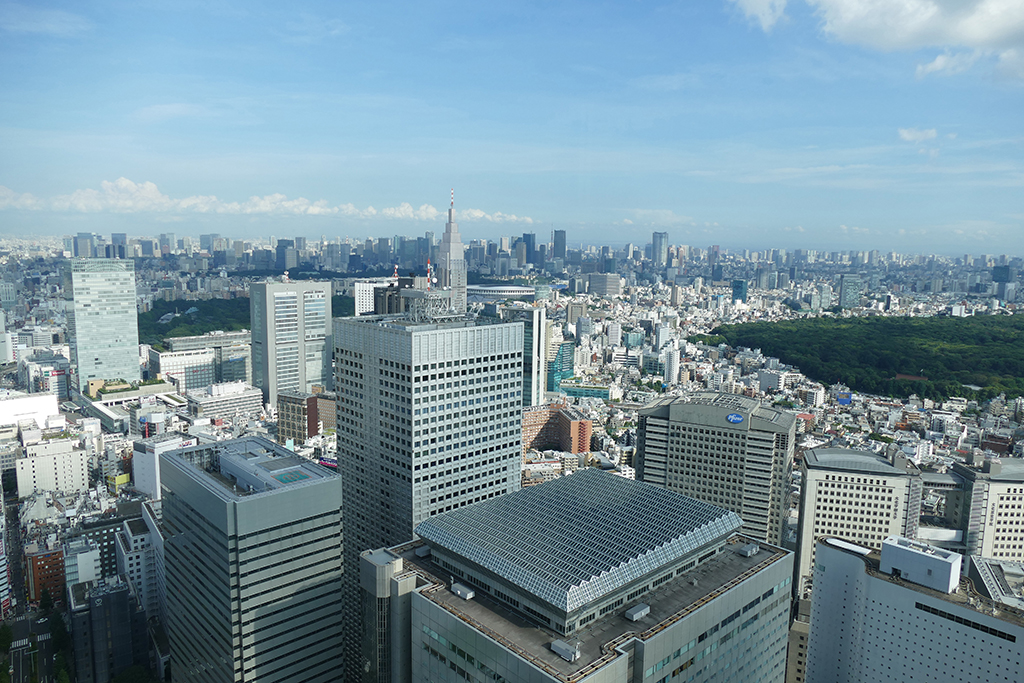
From here, you have a fantastic view of Tokyo’n’Beyond. You can take a pleasant coffee break at the bar in the center of the glassed observation deck and stock up on some souvenirs. And believe it or not – going up there is completely free of charge!
Who said Tokyo was expensive?!
I was amazed by all I’d seen in one day – especially by the overwhelming views from the Government Building. It was late in the afternoon, I could have just grabbed a bite and called it a day.
Roppongi
But not so fast, there was a last important stop on my list. Last, but by no means least: Roppongi, the top-notch neighborhood just southeast of Shinjuku.

It is mostly famous for the Roppongi Hills, one of Japan’s largest integrated property development projects. Constructed by Japanese tycoon Minoru Mori, the building complex houses corporate offices, but also luxurious apartments, shops, restaurants, cafés, movie theatres, a hotel, an amphitheater, and several green areas.
In its hearts stands the Mori Tower.

Mori Arts Center
The Mori Tower was completed in 2003 and stands 54 storeys high. Located on floors 49 and up is the Mori Arts Center including various cool venues like the Tokyo City View on the 52nd floor, the Mori Art Museum on the 53rd floor, and the absolutely fascinating roof observatory on the 54th floor – arranged around a helicopter landing place.


The Art Museum does not have a permanent collection but presents changing exhibitions of contemporary artists. I was very lucky to see Chiharu Shiota’s poetic yet disturbing installations. But no matter which show is on, I would always recommend a visit if only for the amazing venue and the breathtaking views.
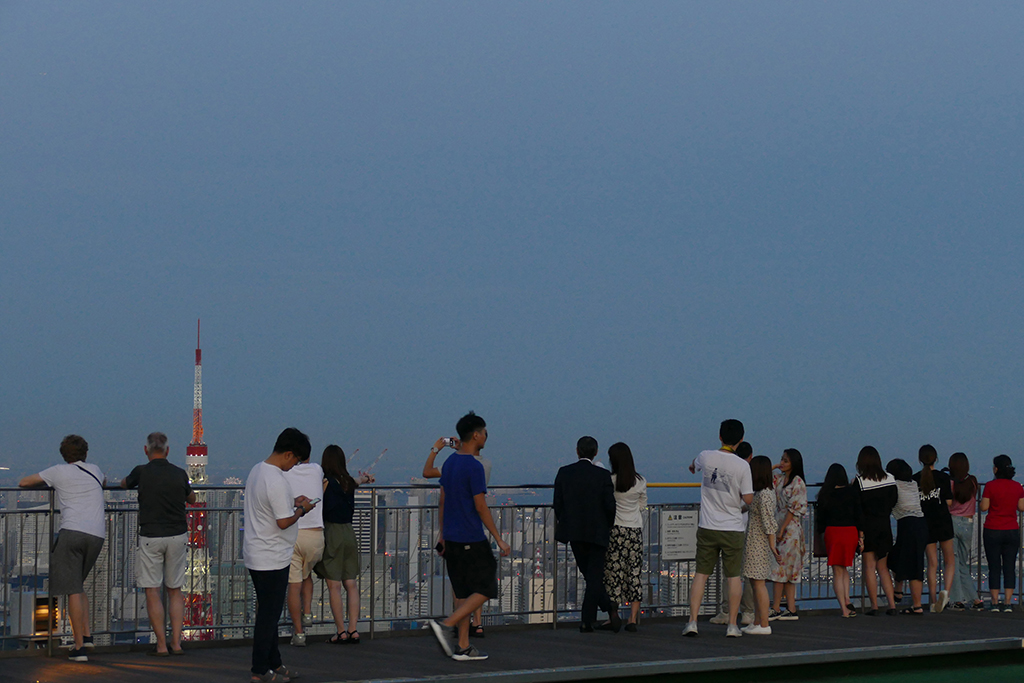
Mori Art Museum
53F Roppongi Hills
Mori Tower
6–10–1 Roppongi
Minato-ku
Tokyo 106-6150
The gallery is open daily from 10 a.m. to 10 p.m., Tuesdays only to 5 p.m.
As a matter of fact, there are three major art museums in trendy Roppongi – called Art Triangle and all within walking distance from each other.
Art Triangle
Besides the Mori Art Museum, there is the National Art Center, a humongous exhibition and cultural space. This impressive venue was opened in 2007 and has no permanent collection, either, but presents various themed temporary exhibitions.

Even if you don’t plan on seeing one of their art shows, you should definitely visit the building, ride the escalator – and be impressed by this outstanding architecture.
The National Art Center
7-22-2 Roppongi
Minato-ku
Tokyo 106–8558
The Art Center is open from Wednesday to Monday from 10 a.m. to 6 p.m., and Fridays to 8 p.m.
Finally, the Suntory Museum of Art focuses on fine, applied, and decorative art. Originally opened in the Marunouchi district in 1961, it was moved to Roppongi in 2007 and completed the Art Triangle.
Suntory Museum of Art
Tokyo Midtown Galleria 3F
9–7–4 Akasaka
Minato-ku
Tokyo 107–8643
The museum is open from Wednesday to Monday from 10 a.m. to 6 p.m., and Fridays to 8 p.m.
Tip: With a ticket from one of these museums, you get a discount on the other two.
At the end of the first day at the first city on my first trip to enigmatic Japan, while enjoying my first real Japanese dinner at Sakura Shokudo Roppongi Hills, I felt great and inspired – having found much more than I expected and ever imagined.

Sakura Shokudo
Roppongi Hills
Minato-ku
Tokyo 106-0032
The restaurant is open daily from 11 a. m. to 11 p. m.
Ueno + Imperial Garden + Tokyo Station
Ueno Park
I’m guided into the next day by a big board at the entrance to Ueno Park located about a ten-minute walk from my hotel. Besides about two dozen other regulations it also points out that smoking at the park is prohibited.
Fair enough, I quit about 20 years ago.
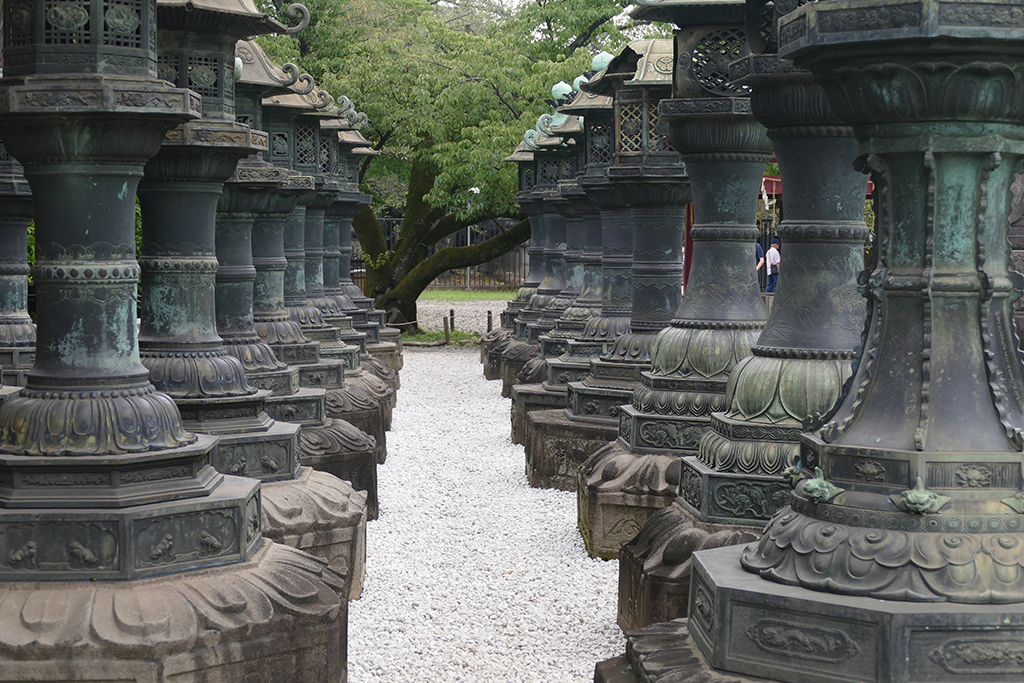
Walking down the tarred trails, about every 15 feet, there is a sign embedded in the pavement showing a crossed-out cigarette. In case someone skipped this particular rule on the board at the gate.
These signs make it pretty clear even to illiterate smokers: Do! Not! Smoke! Here!
But Japanese rule-makers take no chances, therefore there are announcements from the speakers that must be hidden somewhere in the trees. They are announcing that – take a wild guess – smoking is prohibited at the park; and once they are on it, the voice keeps on lecturing the promenaders how smoking, in general, is not good for you and you shouldn’t….and so on and so forth….and this morning promenade turns out to be far more educational than expected.
Mentally, I can still get pretty juvenile. I feel like these lectures evoke an inner protest in me. If the voice keeps lecturing, I might buy a pack of cigarettes – the first pack after about 20 years.

Ueno Park was established in 1873 as one of the country’s first public parks. While to us Japanese gardens are the epitome of manicured nature, the park’s layout follows a rather Western style.
Trees’N’Treasures
The park is not only home to almost 9,000 trees – many of them are different cherry trees that transform Ueno Park in spring into a fairyland. But of course, there are also lawns’n’shrubs, and the Shinobazu Pond is covered by lotus beds.

Also, if you want to admire some of Tokyo’s most important Shrines and Pagodas, you cannot skip Ueno Park: There is the Shinto Shrine, the Gojo Tenjinsha, the Ueno Daibatsu, the Toshogu Shrine, and the Shinobazunoike Bentendo Temple, to mention just the most important ones.

Some of the most important museums such as the National Museum of Western Art, the National Museum of Nature and Science, the Shitamachi Museum, and the Tokyo Metropolitan Art Museum are to be found on the park’s premises as well as the Ueno Zoo, hence, it’s no wonder that this garden is Japan’s most popular city park, attracting over ten million visitors every year.

Imperial Garden and Palace
I was so proud and felt kissed by lady luck as I snatched the very last ticket for a guided tour of the Imperial Palace.
As a matter of fact, tickets are free of charge and you can also get them on the spot. Since only 500 visitors per day are admitted – divided into two groups, general entry is on a first come first serve basis. A total of about 50 tickets per day are available online. I got the very last one available during my visit to Japan. Big deal, that’s what I was thinking.

The Imperial Palace complex is part of the Imperial Palace Garden. The so-called East Garden is open from 9 a.m. to 4 to 6 p.m. in the afternoon – closing time differs by season. The entrance to this park is free of charge. Only the number of visitors to the Imperial Palace complex is limited.
I got to the Imperial Palace entrance half an hour before the designated visiting time as requested on my precious reservation.
There was a small group of people waiting under a tree, their names being checked off from a list.
A bit apart, a large group of people was waiting in a very long line along a fence.
The small group got a green lanyard with a plastic card, and the large group a red one. Eventually, they let the entire crowd in at the same time.
Seeking Audience
We were let in means we were led into a large, austere hall with long tables. We sat down and waited. After a while, there was a long announcement in Japanese. Since it was followed by a long announcement in English, I can tell you that we got some brief info on the visiting procedure. Also, we were told to go to the restroom now, to stock up on drinks from the vending machines, and to get some souvenirs at the gift shop. The speech was also held in Chinese, Korean, and Spanish.

Then we kept sitting and waiting. The hall with all these people waiting in anticipation, speaking in different languages somehow reminded me of Ellis Island. I had this image of this large hall where the emigrants fresh off the boat from the old world had to wait to be admitted. Give me your tired, your poor, your huddled masses….
Huddled Masses
These huddled masses were waiting and waiting. Finally, I did use the restroom as recommended. And I got a drink from the vending machine as suggested.
And then the five ladies held the speech in their respective languages again. This time, they added that they were our guides and we would meet them at the doors in a moment.

And then we kept on waiting. Since I had finished up the drink from the vending machine, I had to use the restroom again and I came back just as the crowd started to gather around the five ladies. It was pretty clear that the English-speaking group was by far the largest one.
I quickly redisposed and joined the Spaniards. They were the smallest group with only about twenty people and the guide’s Spanish was really excellent.
Pick Your Flock
To avoid major language clashes, they left an acoustic safety distance between groups as they guided us through the premises. To prevent stray visitors from migrating to other groups, there were guards running around, herding up the individual flocks. This was all so organized – and quite bizarre.

As a matter of fact, their whole organization was far more extrinsic and exciting than what we got to see: I’ve seen many castles in my time – in England and Germany and in France and many other European countries as well as in Asian lands such as Cambodia and Thailand. But never have I seen a Palace this…modest…unadorned…unremarkable…unimpressive. As a matter of fact, hadn’t I known that this was the Imperial Palace complex, I would have believed to visit some industrial plant.
After one hour of being guided and ushered crisscross the premises, we were escorted back to the main gate. There we had to hand them our lanyard with the plastic card – and that was it for Tokyo’s Imperial Palace.

So, was it worth it? Honestly? No, it wasn’t. Although I had made a reservation and did not have to be there well ahead of time, I had to wait forever at their Ellis Island. As a matter of fact, the wait was approximately as long as the tour. And like I said, neither the buildings nor the gardens are in any way outstanding.
The procedure and über-organization, however, were unexpectedly funny; but you just read how it went so you don’t need to experience it yourself and can do something more fun when in Tokyo.
How To Visit
If you are determined to experience this yourself, check on the Imperial Household Agency’s website if you can make a reservation for the day of your choice.
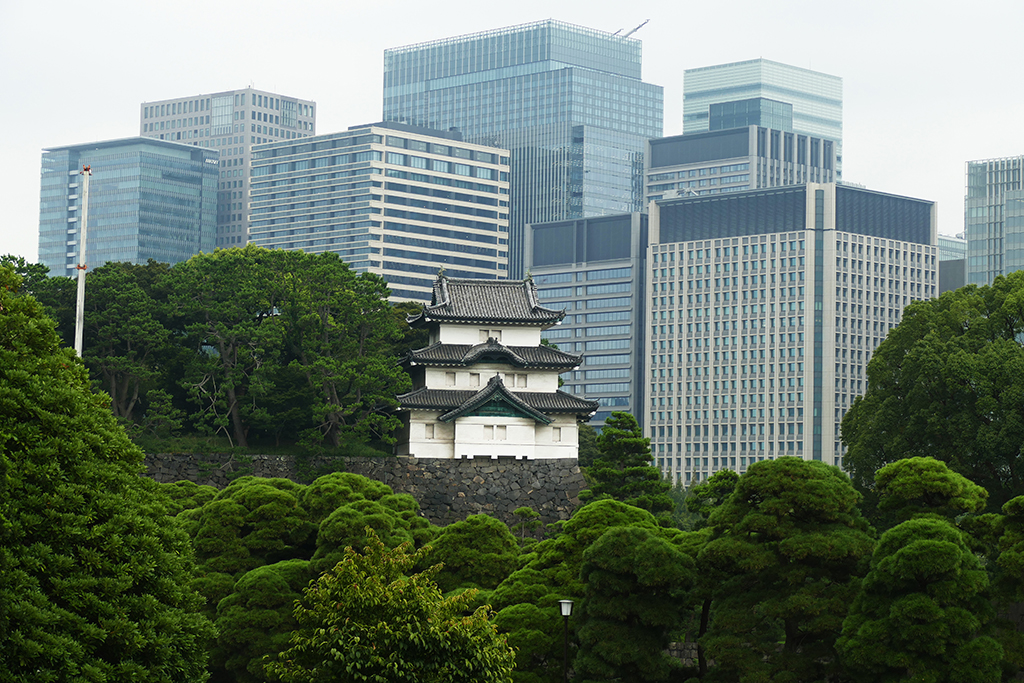
But note that the Imperial Palace complex is only a smaller part of the Imperial Palace Gardens that can be visited during the opening hours also free of charge.
Tokyo Station
After my tour, I was ready for refreshment and just a couple of blocks east of the gardens is the grand Tokyo Station. It’s not only famous for trains. It’s also celebrated for its subterranean Cockaignes: Ramen Street and Kitchen Street.
The older part of the station is in the Marunouchi business district just a couple of blocks from the Imperial Palace. It was opened in 1914. The newer extension spreads towards the Ginza commercial district.
Subterranean passageways are linking the station to various subway stations. This way, you practically don’t need to come to the pithead for miles. It’s really impressive – and I must admit that I needed to get used to this Japanese way of living underneath the surface.
Neither did I expect excellent restaurants in these undercrofts, however, there is the so-called
Ramen Street, consisting of eight restaurants specializing in ramen dishes, located on the railway station’s Yaesu wing in the East.
Subterranean Cockaigne
Another food area is called Kitchen Street and can be found in the northern part of the station – of course, also subterranean; makes you really feel like a mole searching for food down there.
Anyway, at Kitchen Street, you’ll find a wider variety of cuisines including not only restaurants, but also delis and markets. Upstairs is the gourmet section – the highest quality for the appropriate prices.
I quickly took the escalator back down.

I quickly found a restaurant where the food was just delicious. Also, it was the sweetest gesture when the waitress brought me a big paper bib. Actually, I was wearing a light blue dress and she must have identified me as an eating-very-long-noodles-with-chopstick-novice. I hesitated a short moment – and then gratefully accepted – being an eating-very-long-noodles-with-chopstick-novice, after all.

Kamatake Udon Yaesu Kitaguchi
1-9-1 Marunouchi
1F Kitchen Street
Tokyo 100-0005
They are open every day from 11 a.m. to 11 p.m.
Tsukiji + Ginza + Asakusa
Tsukiji
I’m not such a sucker for markets, but I must admit that the so-called Tsukiji Outer Market is quite impressive.

Initially, the Outer Market started out as a by-catch – pun intended – of the old Tsukiji market which was for wholesalers only. From this commercial nucleus, being very popular with visitors from all over the world, emerged the so-called Outer Market.

To this day, the fish market – and especially the famous tuna auction – is in basically every Tokyo guidebook. However, this professional part moved to the new Toyosu Market about two kilometers further south while the good old Outer Market still remained at Tsukiji.
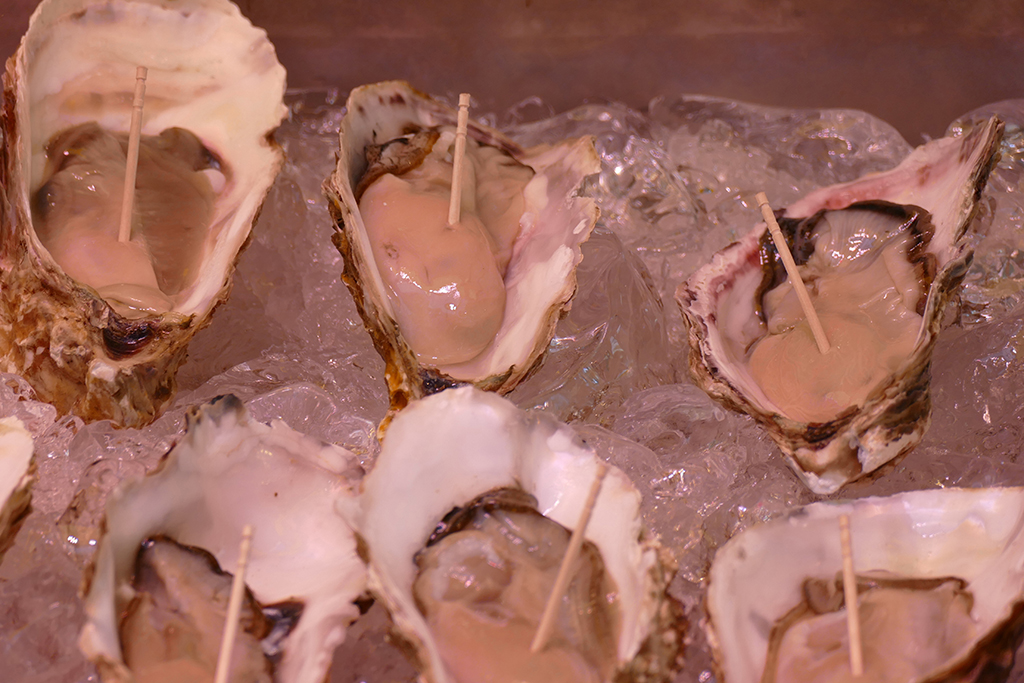

The vendors and cooks at the Outer Market still get fresh produce from the wholesalers at Toyosu. The overwhelming variety of freshly sliced sashimi, dried seaweed, exotic fruit, and fresh and pickled vegetables will either make you drool – or at least wake your interest.

However, the market is also a great place to buy some nice souvenirs like sushi knives, kitchen utensils, fancy chopsticks, and beautiful ceramic bowls.

Since the Outer Market closes at 2 p.m., you can come for breakfast or lunch – or just a, literally, fantastic snack.
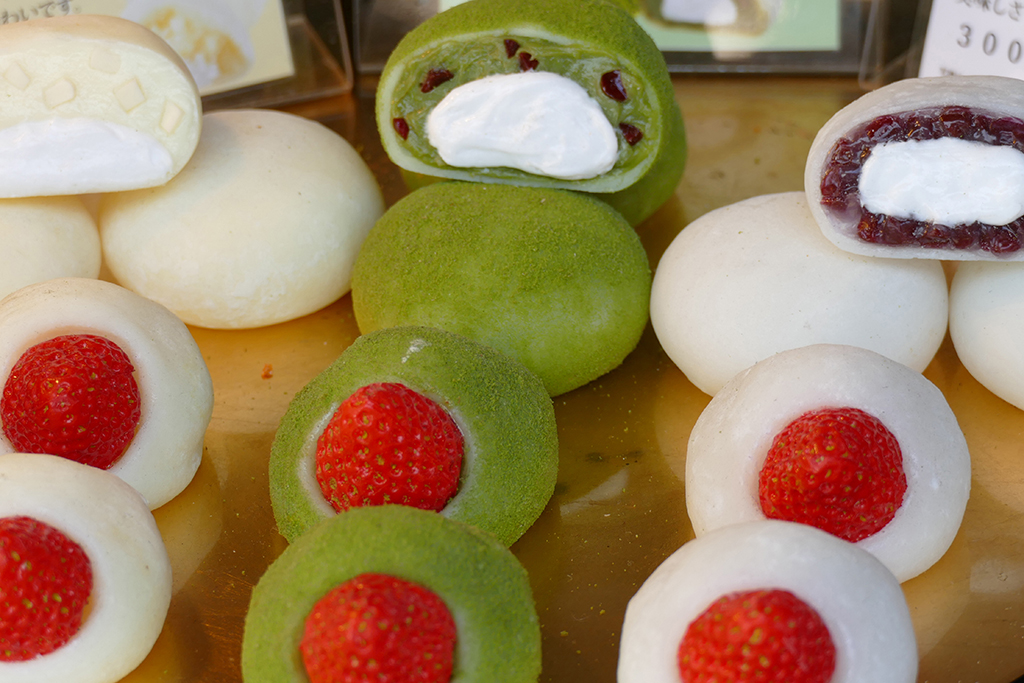
Ginza
Ginza is all glitz’n’glamour. It used to be one of Tokyo’s first neighborhoods in the Tokyo bay. Today, it’s the latest – the latest in fashion, the latest in bars, and the latest in trends.

All the high-end luxury brands make it one of the most elegant and expensive shopping streets in the world.

However, there are also many global chain stores like ZARA and H&M and Japanese ones such as Uniqlo and GU – but even these not-so-exciting brands are presented in spacious, hip flagship stores spread over various floors.

Asakusa
Last, but not least, I’ve visited Asakusa where some of the most important tourist sights are located – and it is also the most traditional part of Tokyo. It used to be famous as a district of the performing arts and also as Tokyo’s oldest geisha neighborhood. This golden era is portrayed in Yasunari Kawabata’s novel The Scarlet Gang of Asakusa.

However, today, the most important attraction is Tokyo’s oldest and most significant Buddhist temple Sensō-ji. Adjacent to the temple is the Asakusa Shinto shrine, a five-story pagoda.

The Sensō-ji is very beautiful, indeed, but man, is it busy – and I was there quite late short before they were closing.

Connecting the entrance called Kaminarimon – or Thunder Gate – and the main temple premises is Nakamise-dōri, a shopping street flanked by stalls where you can buy all sorts of souvenirs – nice’n’cheezy. Although these shops are not just tourist traps but actually part of a living tradition of selling to pilgrims who walk to Sensō-ji, I’d recommend to rather check out the shopping area west of the Sensō-ji complex.
Tip: If you like Kimonos or Yukatas, the traditional Japanese cotton robes, make sure to browse the vintage shops for used ones. They are in perfect condition, squeaky clean, and they cost a fraction of the new ones.
If you haven’t eaten yet, you’ll be delighted by the many typical Japanese foods at the eateries around Asakusa.
Leaving the City of Tokyo
So these are the ten neighborhoods I did visit in a bit over three days. I emphasize visited as opposed to explored or experienced: Three days is far too short for this mega-city and everything there is to see and to do. It made me giggle thinking of how we used to make fun of Japanese tourist groups visiting twelve European cities in seven days, just rushing from place to place.
I, a European in Japan, now travelled practically in the same fashion.
As a matter of fact, you can spend an entire day at Ueno Park without getting bored. You can also spend a – rainy – day exploring the Art Triangle.
This post is just giving you some ideas and some guidance on how to make the most of only three days in Tokyo. Let me inspire you – and then put together your very personal and individual itinerary.

Practical Information
How to Get There
Since most tourists visiting Japan are flying into Tokyo, I probably don’t have to explain to you how to get there – you make it to your flight on time.

Joke apart, there are two airports catering to Tokyo and three long-distance train stations in the city center.
Although Haneda is called International Airport, it is rather a hub for domestic flights. However, it is much closer to Tokyo than the other, primary International Airport Narita, about 60 kilometers east of the city.
There are various options for getting to and from Narita, the Keisei Skyliner being the most reasonable one. According to this timetable, it leaves all terminals every 20 respectively 40 minutes and gets you to the Ueno station in under an hour. Ueno is one of Tokyo’s major hubs so from there you can easily reach your final destination. Your arrival will be particularly easy if you choose accommodation in the neighborhood of Ueno.
If you are coming to Tokyo from another Japanese city, you can either fly into Haneda, take a train, or even an overland bus. Public transportation is very reliable, safe, and clean. However, it is not cheap: A one-way trip from Kyoto to Tokyo on a regular Shinkansen is about 13,500 Yen. A bus ride can set you back up to 8,000 Yen – although it’s mostly a bit cheaper.
However, this is the reason why practically every foreigner is getting a JR pass. Why locals don’t? Because they are not allowed: Only non-residents are entitled to get this – by the way, still very expensive – pass for unlimited travel on the national trains.
Read more about it in my main post on Japan.
How to Get Around
As I mentioned above, public transportation all over Japan and particularly in Tokyo is pretty amazing: buses and most of all different types of trains make local travel easy and smooth. However, it is a big city, and getting from one neighborhood to another might take more time than you think. As is explained, planning your activities in neighboring parts of the city will save you lots of time – and you will need it, as there is much to see.

Take a look at Tokyo’s amazing train map – and don’t worry, once you’re there, all these colorful lines will totally make sense.
Buying tickets, however, is a bit tricky: Not only is there a local train, operated by the national company JR and therefore also included in the legendary JR pass if you have one, and a subway – no, as a matter of fact, there are three different subway companies – and tickets, in general, are not interchangeable.
Too Many Choices
Only if you buy the Tokyo Subway 24-hour Ticket, it’s good for the entire subway network, the Tokyo Metro 24-hour Ticket for 600 Yen is not. There are also day passes for the other metro lines like the Toden One-Day Pass for the Arakawa Line which costs 400 Yen.
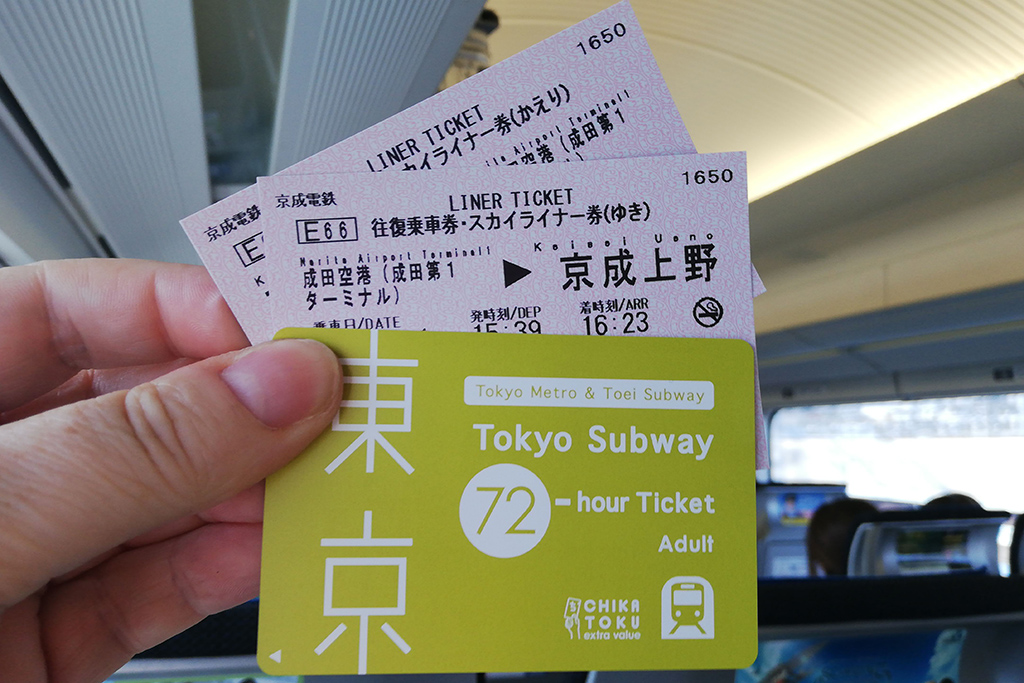
Note that the Subway Ticket is only sold to tourists. Therefore, make sure to bring your passport when buying it on the spot. It costs 800 Yen for 24 hours and also comes in a 48-hour version for 1200 Yen and for 72 hours at 1,500 Yen.
If you don’t have a valid JR pass while in Tokyo, I definitely recommend buying the Keisei Skyliner & Tokyo Subway Ticket package that I’ve mentioned in the chapter above: Return ticket for the sky train plus the number of 24-hour passes that you need.
Mind you, just a one-way ticket from Narita airport to the center costs 2470 Yen. For a round trip plus a 24-hour Subway Ticket sets you back 4,780 – that’s already less than two individual rides and you have the public transport practically for free.
Just do it!
Tip: The 24-hour pass is actually valid for 24 hours, not for the day. If you play your cards right and plan your trips accordingly, this might save you a day.
Note: I’ve mentioned the JR pass a couple of times. If you don’t know what it is, make sure to check the respective chapter in the general Japan post – it might save you a lot of money!
Best Place to Stay
I booked a hotel within walking distance of the Ueno station more or less incidentally and must say that it was the perfect spot for arrival. Not only is Ueno ideally located for exploring the city, it also is a junction of various subway lines as well as local and regional trains.
Most importantly, the sky train connecting Tokyo with the Narita airport stops right at the Ueno station so that you enjoy practically door-to-door service from the plane to your hotel room.
There are a couple of hotels around Ueno. I picked the My Stays for the excellent price-performance ratio and wasn’t disappointed. I got one of these 10 square meters rooms, almost antiseptic regarding cleanness and charm. Everything there – from a safebox to a coffee and tee maker, pajamas, and lots of complimentary toiletries.
The price for my room did not include breakfast. However, it costs about 1400 Yen and is absolutely worth the money if you are a halfway good eater. Don’t forget that you’ll pay for just a sandwich and a large coffee at a coffee shop or deli around 1000 Yen.
Here you can check their rates and availability.*
However, if you’d like to check out more great lodging options, you can do so on this map*:
Booking.comBest Place to Eat
I’m sure if you ask a hundred different people about their favorite eatery in Tokyo, you’ll get a hundred different answers. Actually, I never had bad food in Japan – and, after all, it’s also a question of taste.

However, my mouth is still watering when I think of the food at Kitchen Street underneath the Tokyo station.

Joining an Organized Tour
I’m an avid solo-travelling woman. However, in certain countries travelling solo can get a bit lonely. Japan is one of those countries. You get to know far fewer fellow travellers as well as locals than in many other countries. Therefore, to beat solitude, I love to join organized tours here and there.
Hence, here are some great ideas of what to do and which tours to join to see Tokyo in a comfortable and entertaining way*:
Money
The Japanese currency is called Yen and it’s the third most traded currency after the US$ and the €uro. The exchange rate for these currencies is 1 US$ = 152 Yen and 1 €UR = 164 Yen as of March 2024, but you can check the conversion on this page.
Contrary to all these legends about how you hardly can pay with a credit card in Japan, you actually can at basically every hotel, most restaurants, many museums and landmarks, and large stores.

Even if there are some small restaurants, shops, and minor train stations that accept only cash, there will be a convenience store like a 7/11 or a Family Mart within a radius of ten feet where you’ll find an ATM; and at most of these convenience stores, you can also pay with your credit card.
Language
Japanese speak Japanese – fair enough. Since I’d heard that they speak almost exclusively their mother tongue, I was completely freaked out before going to Japan. I hectically downloaded language apps and tried to memorize some Japanese signs. I was afraid of losing my way and never making it back to Europe.
Just like this no credit card thing is basically a myth, there is no reason to be scared of this foreign – and strange – language and its funny letters.

The fact is, most people really have a quite rudimentary knowledge of English. You can slowly and clearly ask for things or direction and people will probably get what you need and find a way to help – even if they cannot actually answer you. More complex matters and conversations, however, might be an issue.

But most importantly, many announcements at stations, in trains, etc. are also in English. Signs at airports, stations, trains, subways, hotels, and all touristy places are also in English. The only time I got a bit lost was on a city bus where the timetable was only in Japanese and the translation app failed.
As a matter of fact, in general, I felt rather overprotected than lost.
Of course, it is a friendly gesture when you are able to say good morning – ohayo gozaimasu, hello – konichiwa, good evening – konbanwa, thank you – arigato gozaimasu and maybe a couple more words in Japanese. Yet you won’t get lost if your knowledge of the language is next to non-existent.
Map
Do you want to read about all the other beautiful places I’ve visited in Japan? Then go to the main post and take your pick!
Before you go, you might want to check out my post on What (not) to pack for JAPAN. It will make your packing easier and consequently your luggage lighter.
Also, there is a post on How (not) to behave in JAPAN that deals with some of the most important rules so you won’t stand out as an ignorant tourist.
Pinnable Pictures
If you choose to pin this post for later, please use one of these pictures:

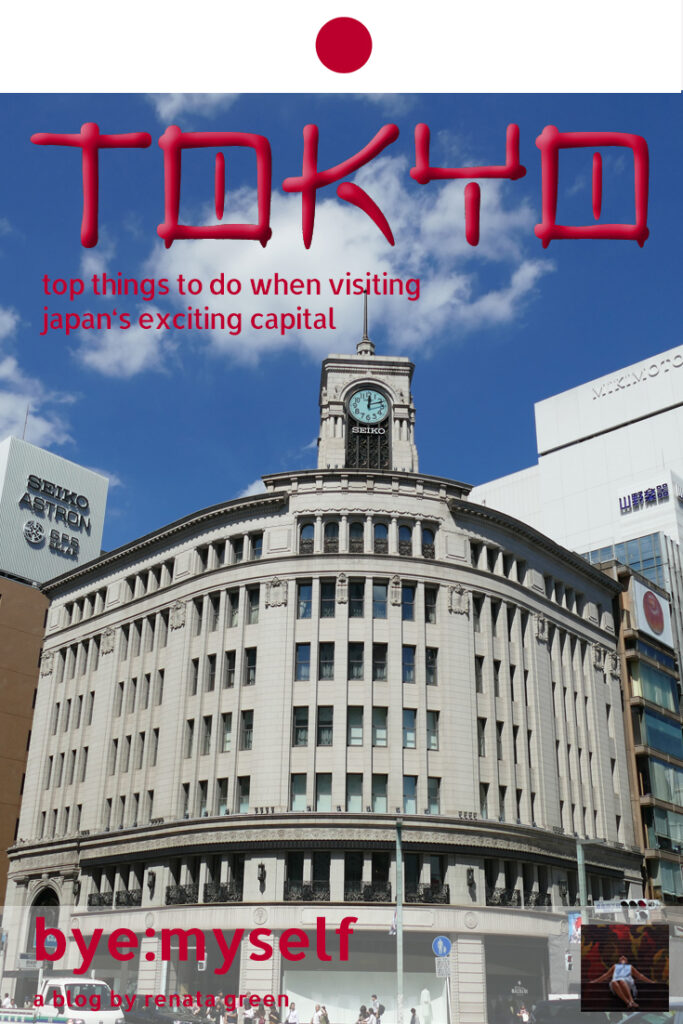

Did You Enjoy This Post? Then You Might Like Also These:
KAWAGUCHIKO – Taking a Shot at Mount Fuji
OSAKA – the commercial metropole; and a side trip to HIMEJI
A night at the KAGURA
HIROSHIMA – risen up from the ashes; and a side trip to MIYAJIMA
How (not) to behave in JAPAN
TAKAYAMA – travel back in time; and a side trip to SHIRAKAWAGO
Guide to NAGOYA – enjoy the ordinary
What (not) to pack for JAPAN
Note: I am completing, editing, and updating this post regularly – last in March 2024.
* This is an affiliate link. If you book through this page, not only do you get the best deal. I also get a small commission that helps me run this blog. Thank you so much for supporting me!

